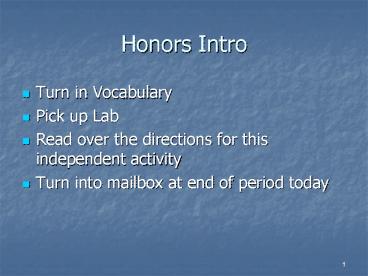Honors Intro - PowerPoint PPT Presentation
1 / 32
Title:
Honors Intro
Description:
Read over the directions for this independent activity. Turn into mailbox at end of period today ... Rolly Polly, Sow Bug, Pill Bug, Potato Bug, Tumble Bug ... – PowerPoint PPT presentation
Number of Views:83
Avg rating:3.0/5.0
Title: Honors Intro
1
Honors Intro
- Turn in Vocabulary
- Pick up Lab
- Read over the directions for this independent
activity - Turn into mailbox at end of period today
2
What do these words mean?
- Binomial Nomenclature
- Dichotomous Key
3
Break the words into parts
- Bi nomial Nomen clature
- Dicho tomous Key
4
Use prefixes and suffixes
- Bi nomial Nomen clature
- 2 name name caller
- Dicho tom ous Key
- 2 parts cut related to access, clarify
5
CP Intro
- Turn in AKS Log Books at the back of the room
- Look over your notes briefly
- Take test
- Turn in to AV cart when done
6
Intro
- Turn in Six Kingdoms Worksheet (Honors) or
Vocabulary (CP) to the mailbox. - Pick up worksheet and save until later in period.
- Answer questions for intro
- Why do we classify organisms?
- What is binomial nomenclature?
- What is a dichotomous key?
- What are the 3 domains and 6 kingdoms?
7
Honors Chapter 17 Organizing Lifes Diversity
CP Chapter 18 Classification
Taxonomy discipline of classifying organisms
and assigning each organism a universally
accepted name
8
18-1 Finding Order in Diversity
- Why do we classify?
- Help to study the diversity of life
- Groups organisms in a logical manner
- Organisms in the same group will be more like
each other
9
Assigning Scientific Names
- We use scientific names
- one name biologists can use everywhere
- eliminate confusion with common names
- Scientific Name
- Armadillidium vulgare
Many different common names for Armadillidium
vulgare
Rolly Polly, Sow Bug, Pill Bug, Potato Bug,
Tumble Bug
10
Naming Organisms
- Binomial Nomenclature
- Developed by Swedish Naturalist Carolus Linnaeus
- Systema Naturae published in 1749
- Each species assigned a 2 part scientific name in
Latin - Genus species (italics with the genus
capitalized) - Armadillidium vulgare
Carolus Linnaeus (1707-1778)
1
2
Genus
Species
11
What is the genus and species of each of these
animals?
- Common name Scientific name
- 1. Domestic dog Canis familiaris
- 2. Puma Puma concolor
- 3. Jaguar Panthera onca
- 4. Lion Panthera leo
- 5. Leopard Panthera pardus
12
Lynnaean System of Classification
Largest (top) to smallest (bottom) King Phil Came
Over For Good Spaghetti
13
3 Domains and 6 Kingdoms
The three-domain system
Bacteria
Archaea
Eukarya
The six-kingdom system
Bacteria
Archaea
Protista
Plantae
Fungi
Animalia
The traditional five-kingdom system
Monera
Protista
Plantae
Fungi
Animalia
14
The Linnaean Hierarchical Classification System
Largest (top) to smallest (bottom) King Phil Came
Over For Good Spaghetti
15
18-2 Modern Evolutionary Classification
- Traditional classification classification based
on similar structures - Evolutionary classification method of grouping
organisms together according to their
evolutionary history - Biologists now group organisms into categories
that represent lines of evolutionary descent, not
just physical similarities.
16
Taxonomic Diagrams
Mammals
Turtles
Lizards and Snakes
Crocodiles
Birds
Mammals
Turtles
Lizards and Snakes
Crocodiles
Birds
taxon
Cladogram
PhylogeneticTree
clade
17
Traditional Classification Cladogram
18
Cladistic Analysis for Evolutionary Classification
- Cladistic analysis identifies and considers only
those characteristics of organisms that are
evolutionary innovations. - Derived Characteristics are characteristics that
appear in recent parts of a lineage, but not in
its older members. - Phylogeny is the evolutionary history of a group
of organisms, as in a family tree - Cladogram is a diagram that shows the
evolutionary relationships among a group of
organisms. - Clade is a common ancestor and all of its
descendents. - Taxonomy is the science of classifying organisms.
- Taxon is a name of any category, such as Animalia.
19
Intro
- First, read items A, B, and C on your handout.
- Then, we will hear current event presentations.
- Next, we will finish up Classification notes.
- Finally, we will do a lab activity to be
completed in class today.
20
Determine Evolutionary Time for Classification
- Similarities in DNA and RNA
- Similar DNA molecules help determine
classification - How closely species are related
- Molecular Clocks
- Use DNA comparisons to estimate length of time
two species have been evolving independently
21
Three DomainsBacteria, Archaea, and Eukarya
- What does the question mark represent?
22
18-3 Kingdoms and Domains
- Today we use a 3 domain and 6 kingdom system of
classification.
23
Domain Bacteria
Streptococcus
24
Domain Archaea
Methanogen
25
Domain Eukarya
- Domain Eukarya has all the eukaryotes
- Protista
- Fungi
- Plantae
- Animalia
Animalia
Protista
Plantae
Fungi
26
Kingdom Protista
Paramecium
27
Kingdom Fungi
Mushrooms
28
Kingdom Plantae
Plants
29
Kingdom Animalia
Animals
30
CW/HW Assignment
- What is the difference between traditional
classification and evolutionary classification? - What is binomial nomenclature?
- Draw a chart listing the 3 domains and 6
kingdoms.
31
Intro
- First, read your Dichotomous Key Lab Worksheet.
- Then, we will hear current event presentations.
- Finally, we will do the lab activity to be
completed in class today.
32
Intro
- Work on lab if not finished from yesterday and
turn in to mailbox. - Work on AKS Log Book turn in tomorrow.
- Work on Reinforcement and Study Guide turn in
tomorrow. - Take test on Classification tomorrow.































